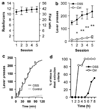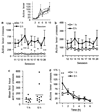Operant sensation seeking engages similar neural substrates to operant drug seeking in C57 mice
- PMID: 19145223
- PMCID: PMC2720253
- DOI: 10.1038/npp.2008.226
Operant sensation seeking engages similar neural substrates to operant drug seeking in C57 mice
Abstract
Novelty and sensation seeking have been associated with elevated drug intake in human and animal studies, suggesting overlap in the circuitry mediating these behaviors. In this study, we found that C57Bl/6J mice readily acquired operant responding for dynamic visual stimuli, a phenomenon we term operant sensation seeking (OSS). Like operant studies using other reinforcers, mice responded on fixed and progressive ratio schedules, were resistant to extinction, and had sustained responding with extended access. We also found that OSS, like psychostimulant self-administration, is sensitive to disruption of dopamine signaling. Low doses of the dopamine antagonist cis-flupenthixol increased active lever responding, an effect reported for psychostimulant self-administration. Additionally, D1-deficient mice failed to acquire OSS, although they readily acquired lever pressing for food. Finally, we found that one common measure of novelty seeking, locomotor activity in a novel open field, did not predict OSS performance. OSS may have predictive validity for screening compounds for use in the treatment of drug addiction. In addition, we also discuss the potential relevance of this animal model to the field of behavioral addictions.
Conflict of interest statement
DISCLOSURE/CONFLICTS OF INTEREST
Christopher Olsen and Danny Winder have no conflicts of interest.
Figures




Similar articles
-
Operant sensation seeking in the mouse.J Vis Exp. 2010 Nov 10;(45):2292. doi: 10.3791/2292. J Vis Exp. 2010. PMID: 21113110 Free PMC article.
-
Lack of self-administration of cocaine in dopamine D1 receptor knock-out mice.J Neurosci. 2007 Nov 28;27(48):13140-50. doi: 10.1523/JNEUROSCI.2284-07.2007. J Neurosci. 2007. PMID: 18045908 Free PMC article.
-
Attenuation of sucrose reinforcement in dopamine D1 receptor deficient mice.Eur J Neurosci. 2003 Feb;17(4):851-62. doi: 10.1046/j.1460-9568.2003.02496.x. Eur J Neurosci. 2003. PMID: 12603275
-
Operant novelty seeking predicts cue-induced reinstatement following cocaine but not water reinforcement in male rats.Psychopharmacology (Berl). 2023 Oct;240(10):2201-2215. doi: 10.1007/s00213-023-06441-4. Epub 2023 Aug 8. Psychopharmacology (Berl). 2023. PMID: 37552291 Free PMC article.
-
Second-order schedules of drug self-administration in animals.Psychopharmacology (Berl). 2002 Oct;163(3-4):327-44. doi: 10.1007/s00213-002-1157-4. Epub 2002 Aug 8. Psychopharmacology (Berl). 2002. PMID: 12373434 Review.
Cited by
-
Role of cues and contexts on drug-seeking behaviour.Br J Pharmacol. 2014 Oct;171(20):4636-72. doi: 10.1111/bph.12735. Epub 2014 Jul 2. Br J Pharmacol. 2014. PMID: 24749941 Free PMC article. Review.
-
Delay discounting in C57BL/6J and DBA/2J mice: adolescent-limited and life-persistent patterns of impulsivity.Behav Neurosci. 2011 Apr;125(2):194-201. doi: 10.1037/a0022919. Behav Neurosci. 2011. PMID: 21463022 Free PMC article.
-
Decreased incubation of fentanyl seeking in the absence of proximal drug-paired stimuli.Exp Clin Psychopharmacol. 2025 Jun;33(3):239-247. doi: 10.1037/pha0000763. Epub 2025 Jan 2. Exp Clin Psychopharmacol. 2025. PMID: 39745674
-
Rewarding Effects of Nicotine Self-administration Increase Over Time in Male and Female Rats.Nicotine Tob Res. 2021 Nov 5;23(12):2117-2126. doi: 10.1093/ntr/ntab097. Nicotine Tob Res. 2021. PMID: 33987656 Free PMC article.
-
An operant ethanol self-administration paradigm that discriminates between appetitive and consummatory behaviors reveals distinct behavioral phenotypes in commonly used rat strains.Neuropharmacology. 2021 Dec 15;201:108836. doi: 10.1016/j.neuropharm.2021.108836. Epub 2021 Oct 12. Neuropharmacology. 2021. PMID: 34648771 Free PMC article.
References
-
- Adams CD, Dickinson A. Instrumental reponding following reinforcer devaluation. Q J Exp Psychol. 1981;33B:109–121.
-
- Ahmed SH, Koob GF. Transition from moderate to excessive drug intake: change in hedonic set point. Science. 1998;282:298–300. - PubMed
-
- Ahmed SH, Koob GF. Changes in response to a dopamine receptor antagonist in rats with escalating cocaine intake. Psychopharmacology. 2004;172:450–454. - PubMed
-
- Ahmed SH, Walker JR, Koob GF. Persistent increase in the motivation to take heroin in rats with a history of drug escalation. Neuropsychopharmacology. 2000;22:413–421. - PubMed
Publication types
MeSH terms
Substances
Grants and funding
LinkOut - more resources
Full Text Sources

